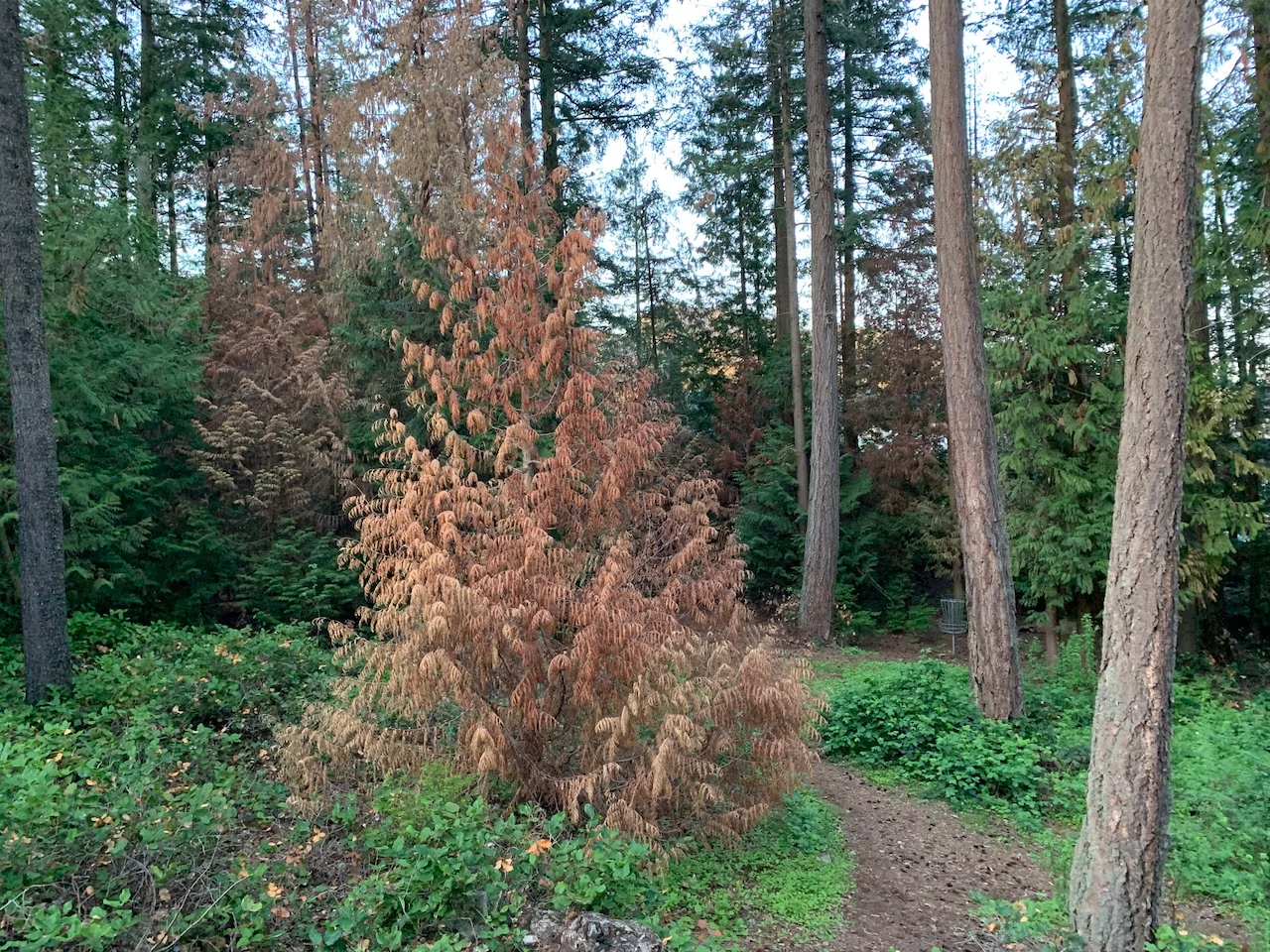7 Reasons Cedar Trees Turning Brown in Saanich, BC
Browning and dieback

Cedar trees are a staple in Saanich’s landscapes, valued for their evergreen beauty, privacy, and adaptability to the region’s mild coastal climate. However, many homeowners in Saanich have noticed their cedar trees turning brown, signalling potential problems that require attention. Browning cedar trees can be caused by environmental stress, pests, diseases, or climate-related challenges specific to the region.
This article will explore the common reasons cedar trees in Saanich, BC, are turning brown and what you can do to help restore their health.
Common Reasons Cedar Trees Are Turning Brown in Saanich, BC
1. Drought Stress and Changing Weather Patterns
Saanich’s increasingly dry summers and lower-than-average rainfall are putting stress on cedar trees. Cedars, especially younger or newly planted trees, require consistent moisture to thrive. Prolonged dry spells can cause browning and dieback.
Signs:
- Browning starts at the tips of branches and spreads inward.
- Dry, cracked soil around the tree’s base.
- The tree may shed entire branches in severe cases.
Solution:
- Water deeply and infrequently, focusing on the root zone. Aim for at least one deep watering per week during the summer.
- Mulch around the base to retain moisture and regulate soil temperature, keeping the mulch a few inches away from the trunk to prevent rot.
2. Root Rot from Poor Drainage
While cedars need consistent moisture, waterlogged soil caused by heavy clay or poor drainage can lead to root rot. This is especially problematic in areas of Saanich with compacted or poorly draining soils.
Signs:
- Browning and wilting throughout the tree.
- Foul smell or black, mushy roots when examined.
- Consistently wet soil around the tree’s base.
Solution:
- Improve drainage by amending the soil with sand or organic matter.
- Avoid overwatering or planting cedars in areas prone to waterlogging.
- If root rot is severe, consult an arborist for potential remediation.
3. Pests
Certain pests are becoming more problematic for cedar trees in Saanich due to shifting weather patterns and tree stress. Common pests include cedar bark beetles, spider mites, and scale insects.
Signs:
- Bark beetles: Tiny holes in the bark, with sawdust-like material at the base of the tree.
- Spider mites: Fine webbing on the underside of leaves and browning foliage.
- Scale insects: Sticky residue (honeydew) on leaves, sometimes accompanied by black sooty mold.
Solution:
- Inspect your tree regularly for signs of pests.
- Use horticultural oil or insecticidal soap to treat mild infestations.
- For severe infestations, consult a professional arborist for effective pest management.
4. Cedar Leaf Blight
Cedar leaf blight, a fungal disease, is common in Saanich due to the region’s wet, humid winters. This disease causes browning and dieback, especially in overcrowded or poorly ventilated areas.
Signs:
- Browning leaves, often with black spots or lesions.
- Premature needle drop, thinning the tree’s foliage.
- Symptoms are worse during or after wet seasons.
Solution:
- Prune affected branches and dispose of them properly to prevent the spread of fungal spores.
- Improve air circulation around the tree by thinning nearby vegetation.
- Apply a fungicide specifically for cedar leaf blight during the early stages of infection.
5. Winter Burn
Cedar trees in exposed areas of Saanich can suffer from winter burn, particularly during cold, dry winds. This condition occurs when the tree loses moisture faster than it can absorb it from frozen or dry soil.
Signs:
- Browning or scorched foliage on the windward side of the tree.
- Damage typically appears in late winter or early spring.
Solution:
- Protect trees from winter winds by planting windbreaks or using burlap wraps.
- Water thoroughly before the ground freezes to ensure adequate moisture levels.
6. Overcrowding and Competition
Many cedar hedges in Saanich are planted too closely together or alongside other trees and shrubs. Overcrowding can lead to competition for sunlight, water, and nutrients, causing weaker trees to turn brown.
Signs:
- Browning on the inner foliage of shaded or weaker trees.
- Slower growth and thinning branches.
Solution:
- Thin out overcrowded plantings to reduce competition and improve air circulation.
- Prune back overhanging branches from neighboring trees to allow more light to reach the cedars.
7. Salt and Pollution Exposure
In urban areas of Saanich, cedar trees may be exposed to road salt or pollutants, particularly if planted near streets or driveways. Salt can damage roots and cause browning foliage.
Signs:
- Browning near the base or along the side of the tree closest to roads or driveways.
- Poor overall health and slower growth.
Solution:
- Avoid using salt near cedar trees, and rinse off any salt spray with water.
- Use alternative de-icing methods, such as sand or gravel, to protect nearby trees.
How to Prevent Browning in Cedar Trees
To keep your cedar trees healthy and green, follow these best practices:
- Water Consistently: Deep water during dry periods, but avoid overwatering or creating waterlogged soil.
- Prune Regularly: Remove dead or diseased branches to promote healthy growth and improve airflow.
- Fertilize Annually: Apply a balanced, slow-release fertilizer in early spring to ensure the tree has adequate nutrients.
- Protect from Stress: Minimize soil disturbance, avoid planting too close to other trees, and shield trees from harsh winter winds.
- Monitor for Pests and Diseases: Regularly inspect your trees and address issues promptly.
- Choose the Right Location: Plant cedars in well-draining soil with sufficient space for growth and airflow.
When to Call a Professional
If your cedar trees continue to decline despite your efforts, it’s time to consult a professional arborist. A specialist can:
- Diagnose underlying issues such as root rot, pests, or fungal diseases.
- Provide effective treatment solutions tailored to your trees.
- Offer expert pruning and maintenance services to restore your cedar’s health.
Trust Ascent Yard Care for Cedar Tree Care in Saanich, BC
Cedar trees are a vital part of Saanich’s landscape, providing beauty, privacy, and shade. If your cedar trees are turning brown, Ascent Yard Care is here to help. Our expert team specializes in tree care, including pruning, pest management, and disease prevention, to keep your cedar trees healthy and thriving.
Contact Ascent Yard Care today for professional cedar tree care services in Saanich, BC, and let us help your trees return to their lush, green glory!
